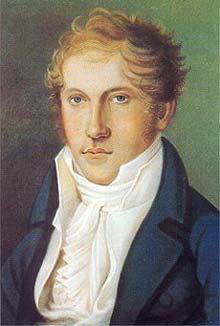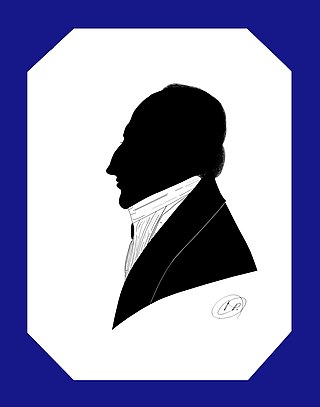Related Research Articles

Louis Spohr, baptized Ludewig Spohr, later often in the modern German form of the name Ludwig, was a German composer, violinist and conductor. Highly regarded during his lifetime, Spohr composed ten symphonies, ten operas, eighteen violin concerti, four clarinet concerti, four oratorios, and various works for small ensemble, chamber music, and art songs. Spohr invented the violin chinrest and the orchestral rehearsal mark. His output spans the transition between Classical and Romantic music, but fell into obscurity following his death, when his music was rarely heard. The late 20th century saw a revival of interest in his oeuvre, especially in Europe.
This is a list of music-related events in 1805.
This article is about music-related events in 1834.

Ludwig van Beethoven's late string quartets are:

Bernhard Molique was a German violinist and composer.
The Quatuor Mosaïques is an Austrian string quartet, founded in 1987 by Erich Höbarth, Andrea Bischof, Anita Mitterer, and Christophe Coin, four members of the Concentus Musicus Wien who play on historical musical instruments. The name of the quartet refers to mosaics and is intended to reference the way details impact on the complete work of art. They specialize in music of the 18th century.

August Joseph Norbert Burgmüller was a German composer.

The String Octet in E-flat major, Op. 20, was written by the 16-year-old Felix Mendelssohn during the fall of 1825 and completed on October 15. Written for four violins, two violas, and two cellos, this work created a new chamber music genre. Conrad Wilson summarizes much of its reception ever since: "Its youthful verve, brilliance and perfection make it one of the miracles of nineteenth-century music." This was one of the first works of Mendelssohn to be very well-received.
The Loewenguth Quartet was a string quartet music ensemble led by the French violinist Alfred Loewenguth. It was particularly famous for performances of classical repertoire such as Beethoven, Mozart and Haydn quartets, and was active from the 1930s to the 1970s.

A string octet is a piece of music written for eight string instruments, or sometimes the group of eight players. It usually consists of four violins, two violas and two cellos, or four violins, two violas, a cello and a double bass.
Louis Spohr's String Quartet No. 30 in A major, Op. 93, was completed in September of 1835, it is one of eight such works Spohr wrote between 1806 and 1835. He would not write another string quartet for ten years.
Louis Spohr's String Quartet No. 11 in E major, Op. 43, was completed in May of 1818. It is one of eight similar works Spohr wrote between 1806 and 1835. Like a concerto, the work is designed to display a soloists skills, but in a more intimate setting than the concert hall.
Potpourri No. 4 in B major, Op. 24, by Louis Spohr, was completed in 1808. The work was one of several compositions that Spohr, a noted violinist, wrote to provide a virtuoso encore when performing more serious chamber works such as Beethoven's Opus 18 string quartets. Written for a virtuoso first violin, with accompanying string trio, like many similar works of this period, was based on themes from popular operas, in this case Mozart's Die Entführung aus dem Serail and Don Giovanni.
Louis Spohr's String Quartet No. 18 in B minor, Op. 61, is one of eight such works the composer wrote between 1806 and 1835, and was published about 1824. Like a concerto, the work is designed to display a soloist's skills, but in a more intimate setting than the concert hall.
Louis Spohr's String Quartet No. 19 in A major, Op. 68, was composed by Spohr in 1823. Like a concerto, the work is designed to display a soloist's skills, but in a more intimate setting than the concert hall.
Louis Spohr's String Quartet No. 6 in G minor, Op. 27, was completed in 1812. Dedicated to Count Razumovsky, the dedicatee of Beethoven, Opus 59. string quartets, the composition, like the earlier String Quartet No. 3, is a concertante work with the musical emphasis being placed on the first violinist, while the other players act as accompaniment. Keith Warsop notes that the second Adagio movement seems to have been adapted from sketches to an unfinished violin concerto.

Joseph Mayseder was an Austrian violin virtuoso and composer.

Federigo Fiorillo was a mandolinist and composer, who wrote thirty-six caprices for violin, also called études.
The quatuor concertant is a special form of string quartet that developed in Paris around 1775 and became one of the leading genres of Parisian music until the French Revolution.
References
- ↑ Brown, Clive; Warsop, Keith. "SPOHR, L.: String Quartets (Complete), Vol. 4 – Nos. 3, 4, 6 (New Budapest Quartet)". Naxos.com. Retrieved September 22, 2012.
- ↑ "String Quartet Op. 11 (Spohr, Louis)". International Music Score Library Project . Retrieved September 22, 2012.